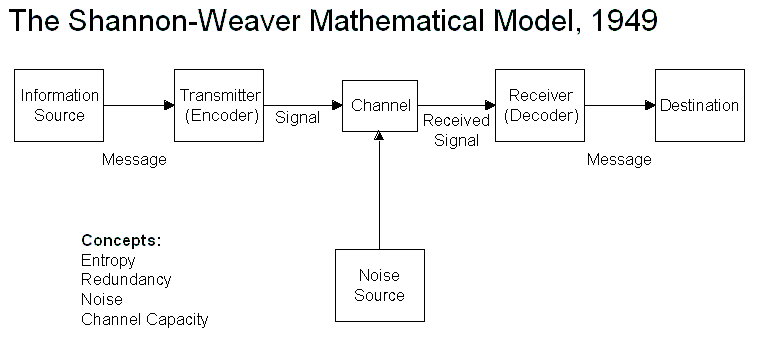Context of Practice
Study Task 1
In 1948, Shannon was an American mathematician, Electronic engineer and Weaver was an American scientist both of them join together to write an article in “Bell System Technical Journal” called “A Mathematical Theory of Communication” and also called as “Shannon-Weaver model of communication”.
This model is specially designed to develop the effective communication between sender and receiver. Also they find factors which affecting the communication process called “Noise”. At first the model was developed to improve the Technical communication. Later it’s widely applied in the field of Communication.
The model deals with various concepts like Information source, transmitter, Noise, channel, message, receiver, channel, information destination, encode and decode.

Sender : The originator of message or the information source selects desire message.
Encoder : The transmitter which converts the message into signals.
Note: The sender’s messages converted into signals like waves or Binary data which is compactable to transmit the messages through cables or satellites. For example: In telephone the voice is converted into wave signals and it transmits through cables.
Decoder : The reception place of the signal which converts signals into message. A reverse process of encode.
Note : The receiver converts those binary data or waves into message which is comfortable and understandable for receiver. Otherwise receiver can’t receive the exact message and it will affect the effective communication between sender and receiver.
Receiver : The destination of the message from sender.
Note : Based on the decoded message the receiver gives their feed back to sender. If the message distracted by noise it will affect the communication flow between sender and receiver.
Noise: The messages are transferred from encoder to decoder through channel. During this process the messages may distracted or affected by physical noise like horn sounds, thunder and crowd noise or encoded signals may distract in the channel during the transmission process which affect the communication flow or the receiver may not receive the correct message.
Note : The model is clearly deals with external noises only which affect the messages or signals from external sources. For example: If there is any problems occur in network which directly affect the mobile phone communication or distract the messages.
Concept Terminology:
re·dun·dant
adjective
1.
characterized by verbosity or unnecessary repetition in expressing ideas; prolix: a redundant style.
2.
being in excess; exceeding what is usual or natural: a redundant part.
3.
having some unusual or extra part or feature.
4.
characterized by superabundance or superfluity: lush, redundant vegetation.
en·tro·py
noun
1.
Thermodynamics .
a.
(on a macroscopic scale) a function of thermodynamic variables, as temperature, pressure, orcomposition, that is a measure of the energy that is not available for work during athermodynamic process. A closed system evolves toward a state of maximum entropy.
b.
(in statistical mechanics) a measure of the randomness of the microscopic constituents of athermodynamic system. Symbol: S
2.
(in data transmission and information theory) a measure of the loss of information in a transmittedsignal or message.
3.
(in cosmology) a hypothetical tendency for the universe to attain a state of maximum homogeneity inwhich all matter is at a uniform temperature (heat death)
4.
a doctrine of inevitable social decline and degeneration.
Channel capacity
noun
noun
The maximum data rate that can be attained over a given channel
Task
Using Shannon & Weaver's model of the communication process, analyse one piece of visual communication.
Make sure you refer to the associated concepts of channel capacity, noise, redundancy and entropy.
Advert:
Guinness basketball commercial
"Reveal the true nature of our characters"
What are the ways in which convention can be said to facilitate understanding?
How does your chosen piece of visual communication that breaks or extend specific conventions?
This advert uses a kind of 'shock' tactic to convey it message to the desired audience. For example, when all but one man remains in a wheelchair after the game.
How does this effect the desire to communicate or the intended audience?
This creates a sense of respect and so will cause effect on the audience in ways that will create desire. Desire to be amongst friends... which Guinness are suggesting 'What better way to socialise than in the pub with a Guinness?'
This creates a sense of respect and so will cause effect on the audience in ways that will create desire. Desire to be amongst friends... which Guinness are suggesting 'What better way to socialise than in the pub with a Guinness?'
No comments:
Post a Comment